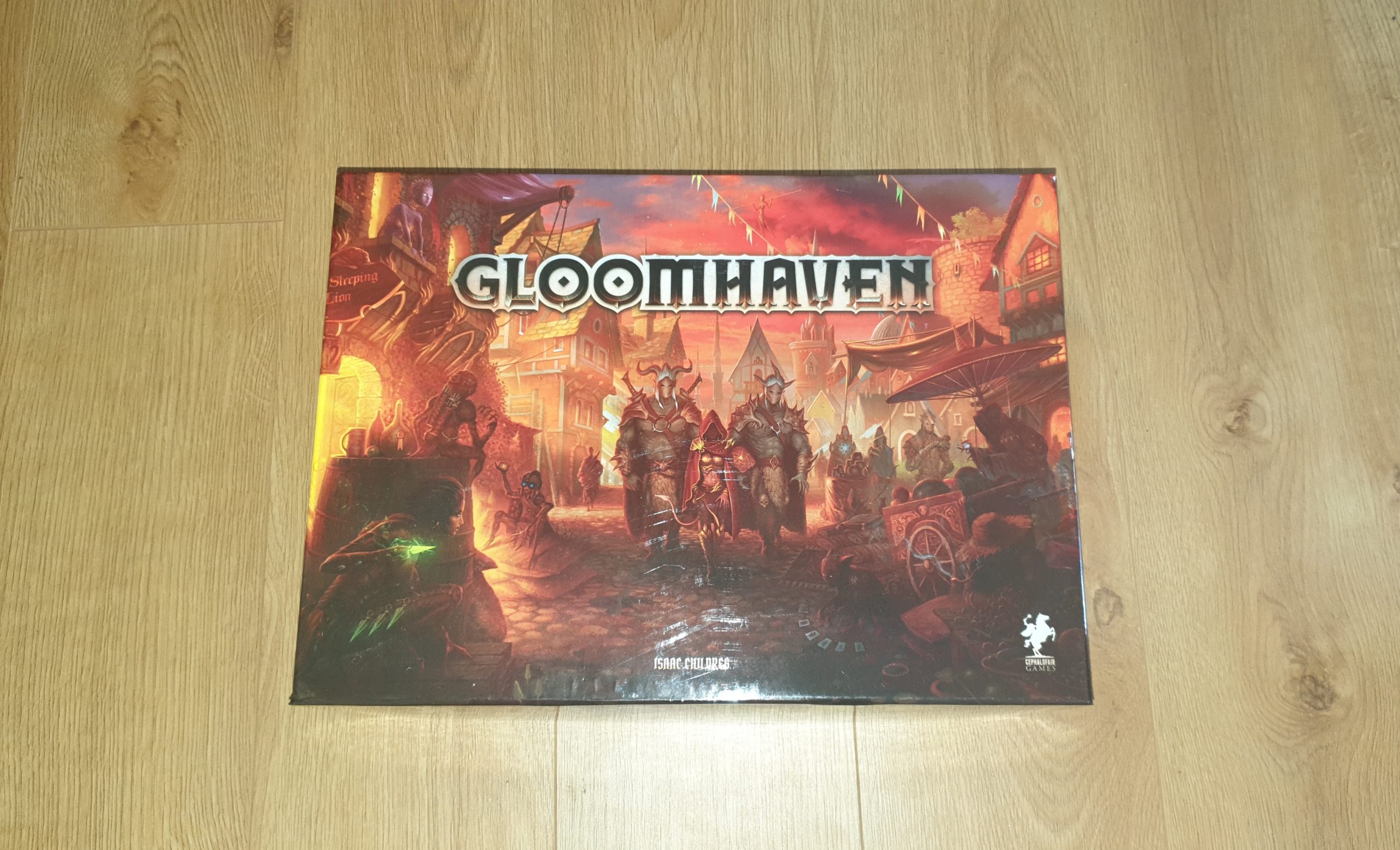Gloomhaven released in 2017 after a successful Kickstarter campaign, by publisher Cephalofair Games. Designed by Isaac Childres, Gloomhaven is a card driven, cooperative, euro-like dungeon crawling board game, with content overflowing out of the large box. Featuring artwork from Alexandr Elichev, Josh T. McDowell and Alvaro Nebot, each scenario can take 1 – 4 players around an hour and a half to play through. However, will players be happy to ditch dice driven combat for card based gameplay? Let’s find out!
Entering the gameworld of Gloomhaven, players take up the roles of mercenaries. While 17 classes are included in the box, only 6 are initially unlocked. Each of these are found in an enclosed box, offering a different gameplay experience – via unique decks of cards and basic stats. Choosing one of these characters, players form a party that is ready to set out on an extensive adventure.
As an overview of the gameplay players will start within the city of Gloomhaven. Performing a road event they will venture out to one of the currently available quests. These road events aren’t always beneficial to players, potentially giving players negative effects for the dungeon they face. The core of the gameplay, the dungeon like scenarios then occur – with card based combat coming into play.
Each round all players choose two cards from their hand, with only limited communication between players. For example, a player could suggest they’d want to rush an archer and attack them. Something not allowed would be giving the exact details of the cards being played. Every card has a top ability, bottom ability and an initiative value. Played as a pair the player must choose which is the lead card – which determines their initiative for the round.
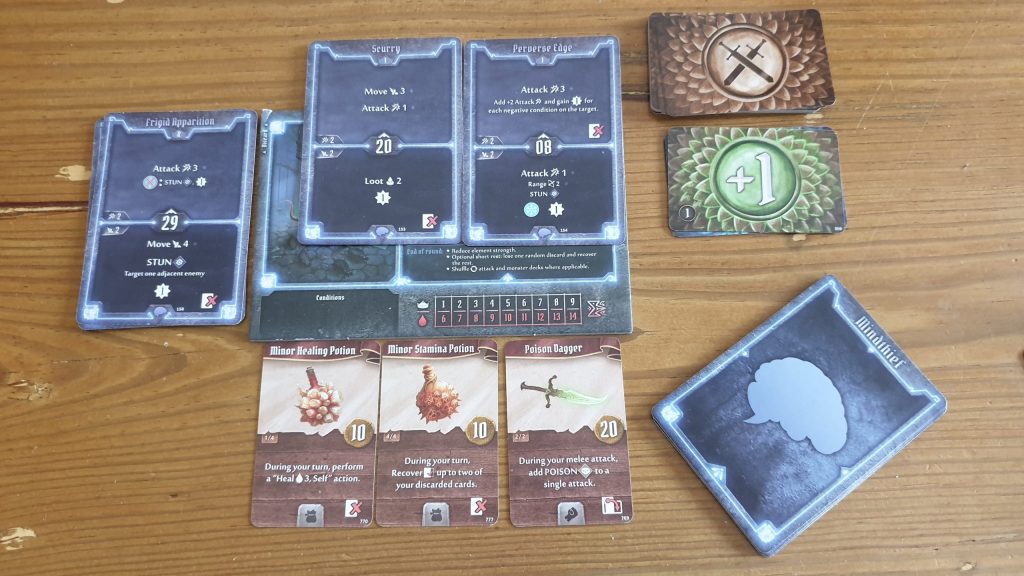
Monsters are driven by their own shuffled decks. These cards reveal what all monsters of that type will do in the round and an initiative value that sees players and monster turns ordered by. To make it interesting players won’t just be coming up against boring guards each game. With the undead, elemental spirits, and even unique bosses to overcome there is plenty standing in your way.
When your turn in the initiative order comes it is time to use the two cards played. Regardless of which was used for initiative the player must use the top action of one and bottom action of the other. With actions such as ranged attacks, devastating area of effect attacks or even simple stuns, any top action can instead be used as a basic 2 strength attack and any bottom action used as 2 movement. With diceless combat attacks deal damage based on the strength listed on the card, which is then altered by the attacking player’s (or monster’s) modifier deck. This is a deck that can be upgraded as players advance in level, offering cards from x2, +1, -2, complete misses and more. Whatever is drawn is used to modify the basic strength of the attack to damage the unit being attacked.
Attacking can also modified by a whole list of effects, from disarming an opponent (causing them to be unable to attack) to shields (which can sponge damage taken). With so many it can be a little daunting at first but thankfully there are reference cards for the effects – limiting the need to have your head in the rulebook. Movement is very simple to perform, moving a number of hexagons – up to the limit the card played gives. There are limitations and even difficult terrain that makes it harder to move, but these are logical and are slowly introduced.
Most of the time cards will be simply discarded when used, though some are put into play for a period of time or lost. To gain discarded cards back a player must rest. A short rest can be performed at the end of a turn, seeing the discarded cards shuffled and one randomly lost. A long rest sets a player’s initiative to 99 and means they do nothing else for a whole round. They still lose a card to their lost pile but get to choose which. Plus this method gains the player 2 health.
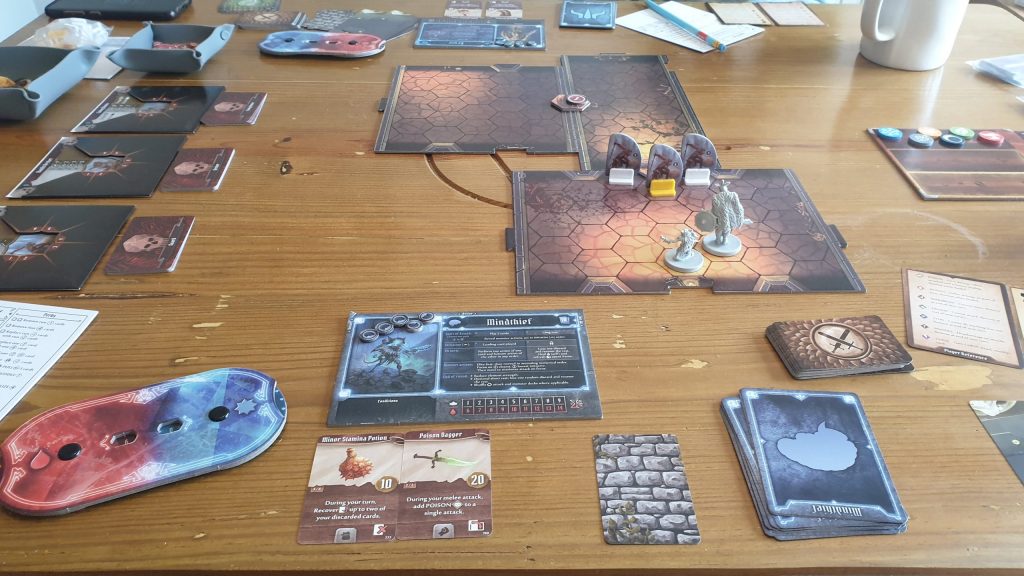
With all of the cards in hand at one time players have the choices of what combos they want to use. This means that the players can attempt to line up for a dramatic and awesome turn. Short rests, initiative values and the monster turns are there to potentially spoil plans. Nevertheless, this is an experience where you aren’t necessarily waiting to draw the cards you need to pull something off, instead players are left to determine if it is worthwhile.
When you have a full hand of cards, going out of the way to grab that alluring treasure or pile of coins is more than just tempting. Towards the end of the mission though, where cards are mostly lost it seems more dangerous. This is because the cards players hold are effectively a stamina bar, once the player can no longer play two cards, or gain enough back from resting, they are out of the scenario – becoming exhausted.
A scenario continues out until either the players become exhausted (dieing also being classed as exhausted), which sees the team fail, or successfully completing the objective. For the most part this involves barging through all of the doors of the scenario and killing all of the monsters.
Though other objectives get spliced in from time to time. With loot to be collected along the way as soon as either of these conditions is met the scenario ends. Each scenario can only be successfully completed once as part of the legacy style campaign – though each can be replayed individually as one shot dungeons. Upon completion, these quests will unlock future content in the form of quests, plot and more. New quests are added to the map board via stickers, with the successful one ticked off. If players fail a scenario they are able to retry and things such as XP earnt are still added to your character sheet.
After a scenario there isn’t just tear down time, which is a lengthy process. There are elements of bookkeeping, stickers to be used and more. If possible it is advisable to leave the game set up if you are likely to play again soon. Still, it isn’t as if the board and monsters involved won’t change. Returning to Gloomhaven however slows the process more, due to city events, leveling and purchasing. Players even need to make a note where the party ends the session. This means that you need to set aside a good chunk of time to get the game to the table, play and pack away.
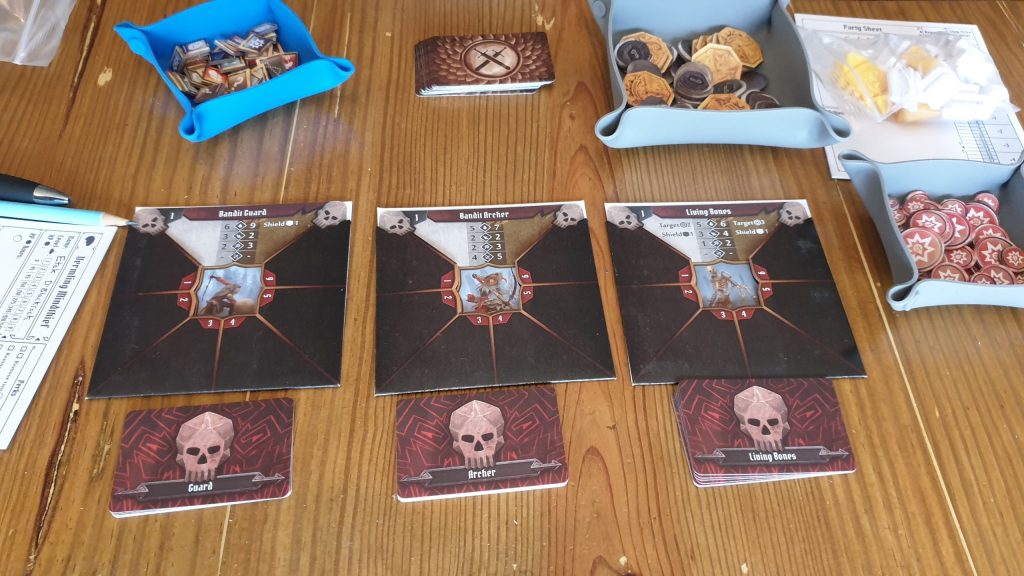
Characters will build up gold and experience from completing quests, with experience not earnt for killing monsters but playing cards. Levelling up will increase a character’s base health. It also unlocks a new card that the player can use when building their hand for a scenario. Items, of which fall into the basic categories of single handed, double handed, small item, boots, etc. can be purchased to help characters on their journey. Note, gold cannot be pooled between players, they are supposed to be individual mercenaries merely teaming up for the quests.
Characters can also complete their life goal like personal quests. These see the character retire, unlocking some new content, with the player getting to choose a new character box to open and play with. This is somewhat of an odd experience. As a campaign driven game the opening of boxes for new content isn’t the main driver, unlike most legacy experiences. Players form an attachment with their character, knowing their deck inside and out. Having to give this up for a new piece of content therefore is bittersweet. There is a fun side to something new but a sad side to no longer being that character.
Without dice there is a factor of calculation rather than risk in the gameplay. Whilst there is a modifier deck, which replicates some of the impact dice have, it doesn’t feel as if anything is possible. This is odd as mechanically crits and epic misses can both still occur. However, the difference between a deck and a die is changing odds. Unless a reshuffle symbol appears cards flipped over are discarded, reducing or increasing the odds a crit or a miss will occur. This minor tweak makes all the difference.
Gloomhaven’s box is overflowing with content. Some components are brilliant while other bits are acceptable for a game of this cost. Every character has its own boxes to store the top quality cards and a miniature. The artwork that adornos the game is stunning making every component ooze theme, from the character boards through to the monster standees – which many would love to see in miniature form instead. For your own sake if you are going to get Gloomhaven order a lot of plastic baggies with it to help organise it all – none are included in the box under the mountain of punchboards. Then, there is a huge map board that is reminiscent of a map seen in Middle Earth, with numbered spaces ready to be added via stickers.
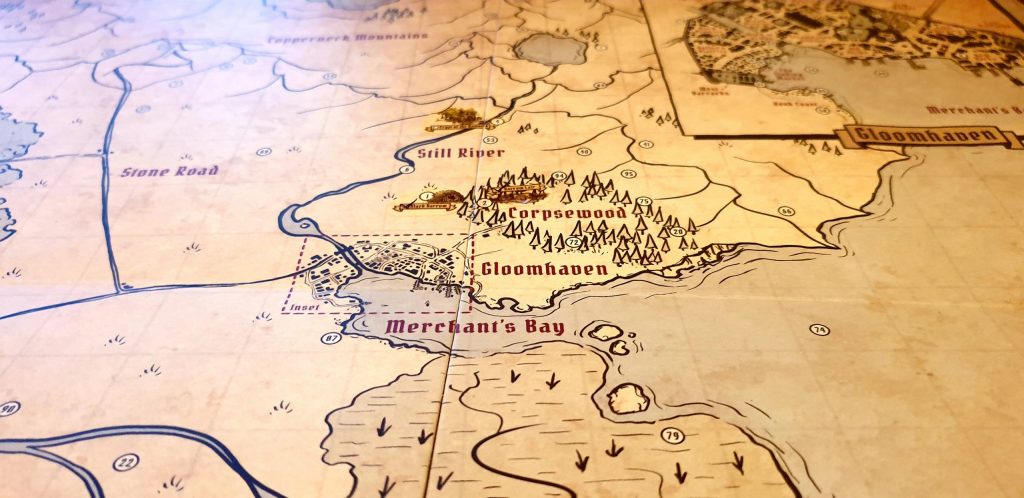
As rulebooks go Gloomhaven’s is certainly on the daunting side, and it is a bit of a slog to get through – more from page count than being unhelpful. The scenario booklet has layouts, lore and objectives for every location, containing secrets and enemies to uncover. The scenario booklet sets Gloomhaven up to be an epic narrative, adding flavour to every encounter – despite the objectives often being generic. There is enough text from the scenario booklet and the event cards though to keep players engrossed in the world.
For those whom come from a more D&D background the initiative track and the controlling of monsters comes fairly simply. This can allow other players to just focus on their role until picking up more of what occurs, enabling them to help out to. This sort of semi-dungeon master role ebbs away over time but it was helpful early on having one player take up the responsibility. Note, there are apps out there including Gloomhaven Helper which are designed to take some of this load off players.
Playing through the levels with two players felt a much smoother experience than my previous dabble in the world of Gloomhaven with four. This was partially due to a couple of AP (Analysis Paralysis) prone players, debating every turn. Slowing the game pacing to a sludge allowed those playing cards promptly to have plenty of downtime, causing their minds to wander from the experience. Keeping the gameplay speed up, the world was able to keep both players immersed, which boosted the engagement and experience. Four players could certainly get enjoyment but all involved would need to be conscious of their decision making time.
The thorn in the side of the 2 player experience is the spikes in difficulty. There were times where the additional spawns for a 3rd player wouldn’t have made a scenario significantly harder. Instead, that third player would have been able to help take down the biggest foe as a combined force. The use of regular and elite monsters, effectively making some hit harder and have more health does blur the lines a bit. It is a trade off, though I still prefer the speed of two – players might just have to game the system from time to time.
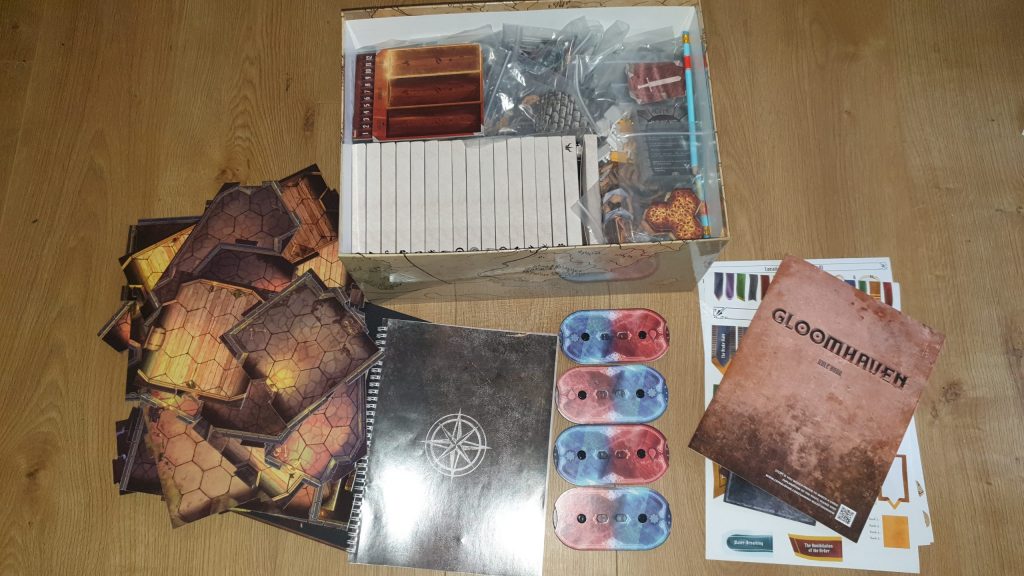
Gloomhaven might not be an experience everyone will finish, there are so many scenarios and hours of content. Still, this is all about the journey that players take, and what occurs along the way. Just like other RPGs your experience will be different. Even playing the same scenario, with the same class, with the same improvements to your deck the order you play the cards can change the outcome or way the scenario plays out. Plus, chances are you’ll be a different class using vastly different abilities.
There are a couple of gameplay elements which don’t sit right with me but are to some extent necessary. Players are supposed to be part of a band of mercenaries, all out for themselves. Thematically it may make sense but when playing not being able to pool gold earnt can be annoying. The other aspect of that ties in with this is looting. Players must loot everything they want before a scenario ends. This can see the final enemy slain and the loot chest placed behind them unable to be claimed. Surely, anyone would slay the enemies then just grab the loot before moving on. This is done so the stamina like card play works, so in mid-battle going for the loot costs the player something. It just feels weird from a player’s perspective.
Gloomhaven isn’t without faults. It isn’t the easiest to get to the table due to the time needed above simply playing. Most of this time is caused by the lack of a way to organise the content in the box. Another problem is that there aren’t a few simple dungeons to introduce brand new players to the experience, players simply set out on the journey. The journey itself doesn’t let players do anything they can imagine in the incredible world that has been crafted. Thankfully, there are ample choices along the way, with branches of content to follow, stories to experience and content to unlock.
The core gameplay is almost easy to understand once you’ve survived the rulebook. Turns consist of only playing two cards and following actions. All of the effects and modifiers add complexity, though they are needed to give a richness to the combat that otherwise would become stale. Every scenario is like a new puzzle to solve, rather than a combat to survive. Some may not like this Euro-like approach, there is no doubt though that Gloomhaven offers a new and different way to play a dungeon crawl. For the stories, characters, items and more yet to discover, Gloomhaven will continue to hit the table for many months to come – even if some of its quirks make it not always simple to do so.
(Editor’s Note: Gloomhaven was provided to us by Asmodee for the review. The game is currently available from local board game stores, some of which are running delivery dropoff services, find your local store here.)

